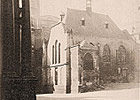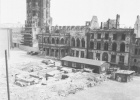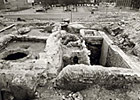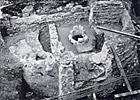Archaeological Zone/Jewish Museum
One of the largest archaeological zones in Europe is taking shape!
As part of the Regionale 2010 programme, the City of Cologne and the State of North-Rhine Westphalia are realising a museum environment in and under the Town Hall Square with a total area of approximately 10 000 m2 with 7500 m2 of exhibition space.
The secular heart of Cologne's urban history will be presented, ranging from the monumental ruins of the Roman Governor's Palace to the fragile remains of one of the most significant Jewish Quarters in Europe.
As an integrative element of the Archaeological Zone, the museum building at the Rathausplatz (Town Hall Square) will be dedicated in particular to the Jewish cultural heritage.
History - Excavations in the post-war period
Over 90 per cent of Cologne's historical city centre was destroyed during World War II. Only a few years after the end of the war, the reconstruction of the Town Hall and other administrative buildings was initiated. The seventeenth-century ‘Spanischer Bau' (Spanish Building) was heavily damaged and was thus to be replaced by a modern building for the City Council and administration.
In 1953, planning was in full swing toward realisation; but then, the initial earth-moving operations revealed massive walls that the archaeologist Otto Doppelfeld was able to excavate prior to building activities. However, he was only given six months to do so.
Despite heavy resistance, Doppelfeld convinced his opponents and at the same time induced the City Council in a memorable meeting to preserve the features as well as to build a permanent underground protective building. The dimensions of this archaeological crypt, realised by the architect Theodor Teichen by 1956, were unprecedented in Europe. Up to this day, one can take a ride down ‘By Elevator into Roman Times'(Mit dem Fahrstuhl in die Römerzeit) as Rudolf Portner entitled his bestseller in the 1950s) to gaze at the archaeological remains of the Roman Governor's Palace, the Praetorium.
Doppelfeld himself had envisioned showing and excavating more, but his ambitious plans were not implemented. In the 1990s the intention to create a large archaeological zone was pursued by the former Unit for the Protection of Archaeological Monuments and after 1995 by the Cologne Romano-Germanic Museum. Yet, it was not until a few years later that the project was to become reality. The opportunity was given within the framework of the programme Regionale 2010 and through funding by the state of North-Rhine Westphalia.
For the implementation of the project, a new bureau, the Archaologische Zone (Archaeological Zone) was embedded in the Cologne Department of Culture. In 2007 a top scientific board was convened that, since then, assembles several times a year under the chairmanship of the Mayor of Cologne and accompanies the project scientifically.









